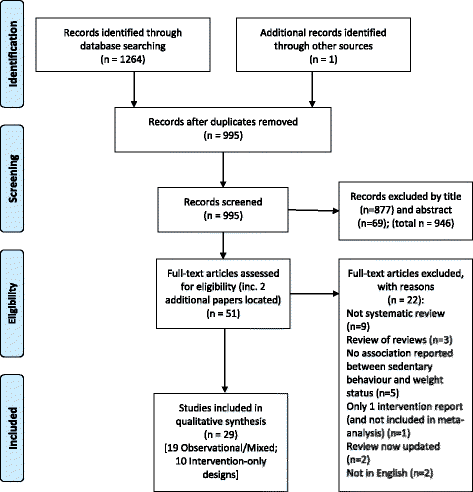Sedentary behaviour and adiposity in youth: a systematic review of reviews and analysis of causality
- PMID: 28351363
- PMCID: PMC5371200
- DOI: 10.1186/s12966-017-0497-8
Sedentary behaviour and adiposity in youth: a systematic review of reviews and analysis of causality
Abstract
Background: Sedentary behaviour (sitting time) has becoming a very popular topic for research and translation since early studies on TV viewing in children in the 1980s. The most studied area for sedentary behaviour health outcomes has been adiposity in young people. However, the literature is replete with inconsistencies.
Methods: We conducted a systematic review of systematic reviews and meta-analyses to provide a comprehensive analysis of evidence and state-of-the-art synthesis on whether sedentary behaviours are associated with adiposity in young people, and to what extent any association can be considered 'causal'. Searches yielded 29 systematic reviews of over 450 separate papers. We analysed results by observational (cross-sectional and longitudinal) and intervention designs.
Results: Small associations were reported for screen time and adiposity from cross-sectional evidence, but associations were less consistent from longitudinal studies. Studies using objective accelerometer measures of sedentary behaviour yielded null associations. Most studies assessed BMI/BMI-z. Interventions to reduce sedentary behaviour produced modest effects for weight status and adiposity. Accounting for effects from sedentary behaviour reduction alone is difficult as many interventions included additional changes in behaviour, such as physical activity and dietary intake. Analysis of causality guided by the classic Bradford Hill criteria concluded that there is no evidence for a causal association between sedentary behaviour and adiposity in youth, although a small dose-response association exists.
Conclusions: Associations between sedentary behaviour and adiposity in children and adolescents are small to very small and there is little to no evidence that this association is causal. This remains a complex field with different exposure and outcome measures and research designs. But claims for 'clear' associations between sedentary behaviour and adiposity in youth, and certainly for causality, are premature or misguided.
Keywords: Adolescents; BMI; Children; Obesity; Screen time; Sedentary; Television; Weight status.
Figures
Similar articles
-
Diet, physical activity and behavioural interventions for the treatment of overweight or obese children from the age of 6 to 11 years.Cochrane Database Syst Rev. 2017 Jun 22;6(6):CD012651. doi: 10.1002/14651858.CD012651. Cochrane Database Syst Rev. 2017. PMID: 28639319 Free PMC article.
-
Interventions for promoting habitual exercise in people living with and beyond cancer.Cochrane Database Syst Rev. 2018 Sep 19;9(9):CD010192. doi: 10.1002/14651858.CD010192.pub3. Cochrane Database Syst Rev. 2018. PMID: 30229557 Free PMC article.
-
Drugs for preventing postoperative nausea and vomiting in adults after general anaesthesia: a network meta-analysis.Cochrane Database Syst Rev. 2020 Oct 19;10(10):CD012859. doi: 10.1002/14651858.CD012859.pub2. Cochrane Database Syst Rev. 2020. PMID: 33075160 Free PMC article.
-
Strategies for enhancing the implementation of school-based policies or practices targeting risk factors for chronic disease.Cochrane Database Syst Rev. 2017 Nov 29;11(11):CD011677. doi: 10.1002/14651858.CD011677.pub2. Cochrane Database Syst Rev. 2017. Update in: Cochrane Database Syst Rev. 2022 Aug 29;8:CD011677. doi: 10.1002/14651858.CD011677.pub3. PMID: 29185627 Free PMC article. Updated.
-
Effectiveness and safety of vitamin D in relation to bone health.Evid Rep Technol Assess (Full Rep). 2007 Aug;(158):1-235. Evid Rep Technol Assess (Full Rep). 2007. PMID: 18088161 Free PMC article.
Cited by
-
Evaluation of Physical Fitness, Body Composition, and Adherence to Mediterranean Diet in Adolescents from Estonia: The AdolesHealth Study.Int J Environ Res Public Health. 2019 Nov 14;16(22):4479. doi: 10.3390/ijerph16224479. Int J Environ Res Public Health. 2019. PMID: 31739416 Free PMC article.
-
Influencing factors of obesity in school-age children and adolescents - A systematic review of the literature in the context of obesity monitoring.J Health Monit. 2020 May 7;5(Suppl 2):2-23. doi: 10.25646/6729. eCollection 2020 May. J Health Monit. 2020. PMID: 35146282 Free PMC article.
-
Sedentary behaviors and anxiety among children, adolescents and adults: a systematic review and meta-analysis.BMC Public Health. 2019 Apr 30;19(1):459. doi: 10.1186/s12889-019-6715-3. BMC Public Health. 2019. PMID: 31039760 Free PMC article.
-
Weight Status, Adherence to the Mediterranean Diet, and Physical Fitness in Spanish Children and Adolescents: The Active Health Study.Nutrients. 2020 Jun 4;12(6):1680. doi: 10.3390/nu12061680. Nutrients. 2020. PMID: 32512886 Free PMC article.
-
Associations of physical activity and sedentary time with body composition in Brazilian young adults.Sci Rep. 2019 Apr 1;9(1):5444. doi: 10.1038/s41598-019-41935-2. Sci Rep. 2019. PMID: 30931983 Free PMC article.
References
-
- Wilmot EG, Edwardson CL, Achana FA, Davies MJ, Gorely T, Gray LJ, Khunti K, Yates T, Biddle SJH. Sedentary time in adults and the association with diabetes, cardiovascular disease and death: systematic review and meta-analysis. Diabetologia. 2012;55(11):2895–2905. doi: 10.1007/s00125-012-2677-z. - DOI - PubMed
Publication types
MeSH terms
LinkOut - more resources
Full Text Sources
Other Literature Sources
Medical


